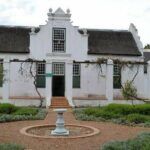Stellenbosch Museum
The museum consists of a complex of buildings including…
SCHREUDERHUIS The first house the museum has restored is the Schreuderhuis. This home was built in 1709, and it survived the first great fire in Stellenbosch.
The second home in the museum complex is BLETTERMANHUIS. This house has been restored and furnished to illustrate a wealthy Stellenbosch home from around the period of 1750 – 1790. Blettermanhuis was built in 1789 by Hendrik Lodewyk Bletterman, who was the last landdrost (magistrate) of Stellenbosch to be appointed by the Dutch East India Company.
Originally built by Christian Ludolph Neethling in 1782, GROSVENOR HOUSE was added to by successive owners until it reached its present appearance in 1803. Grosvenor House, along with Koopmans de Wet House and the Martin Melck House in Cape Town, is one of the most outstanding examples of a two-storeyed, flat-roofed patrician townhouse, of which there was a considerable amount in Stellenbosch as well as in Cape Town
OM BERG HUIS originally had a thatched roof and gables similar to those of Blettermanhuis. During the 19th century, it was altered to look as it does to this day. The home of O.M. Bergh is a typical mid-nineteenth-century home with wallpaper, furniture, and accessories from the period of 1850 – 1870. O.M. Bergh and his family lived in this house from 1836 up to 1877.
THE KRUITHUIS was built by mason Michael Rambusch in 1777. It is an old powder magazine and arsenal from the days of the Dutch East India Company., The building is now home to a collection of firearms, cannons, and military regalia.
37 Ryneveld Street Stellenbosch


